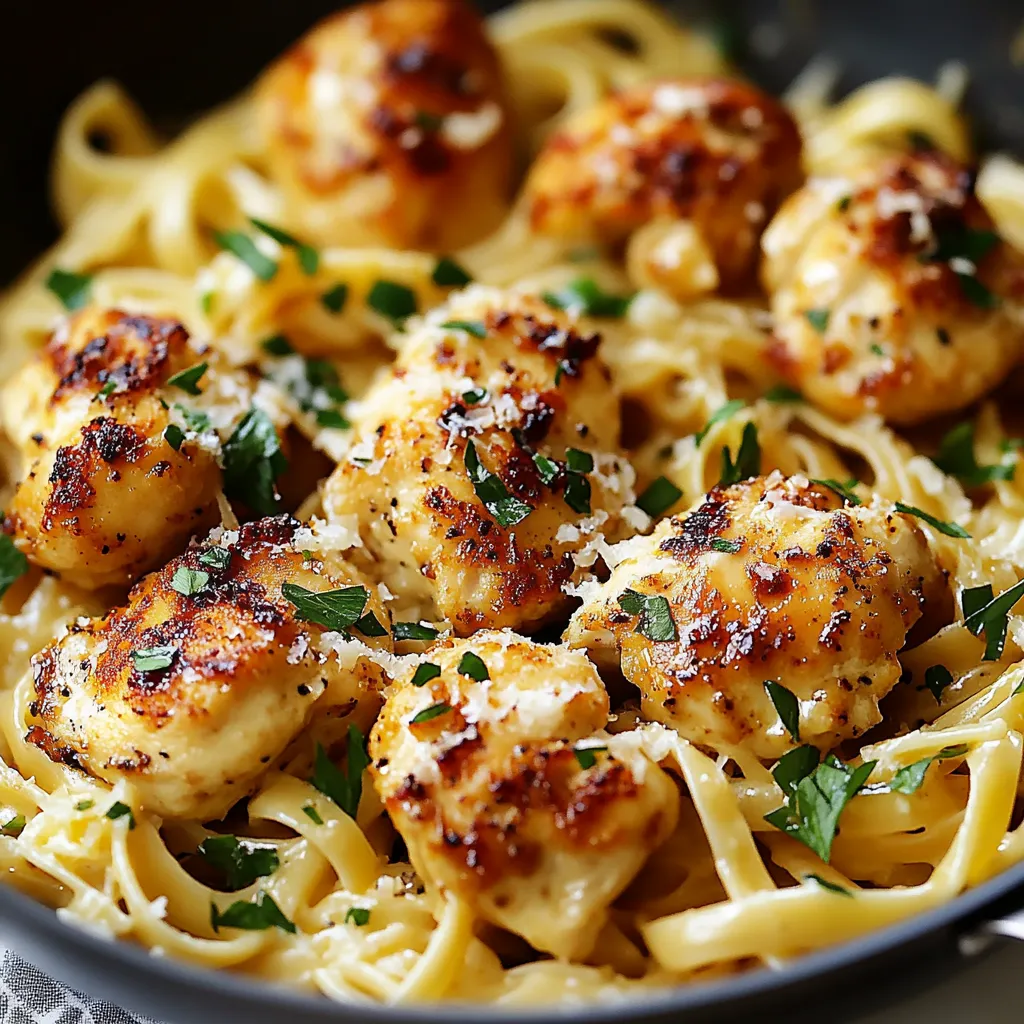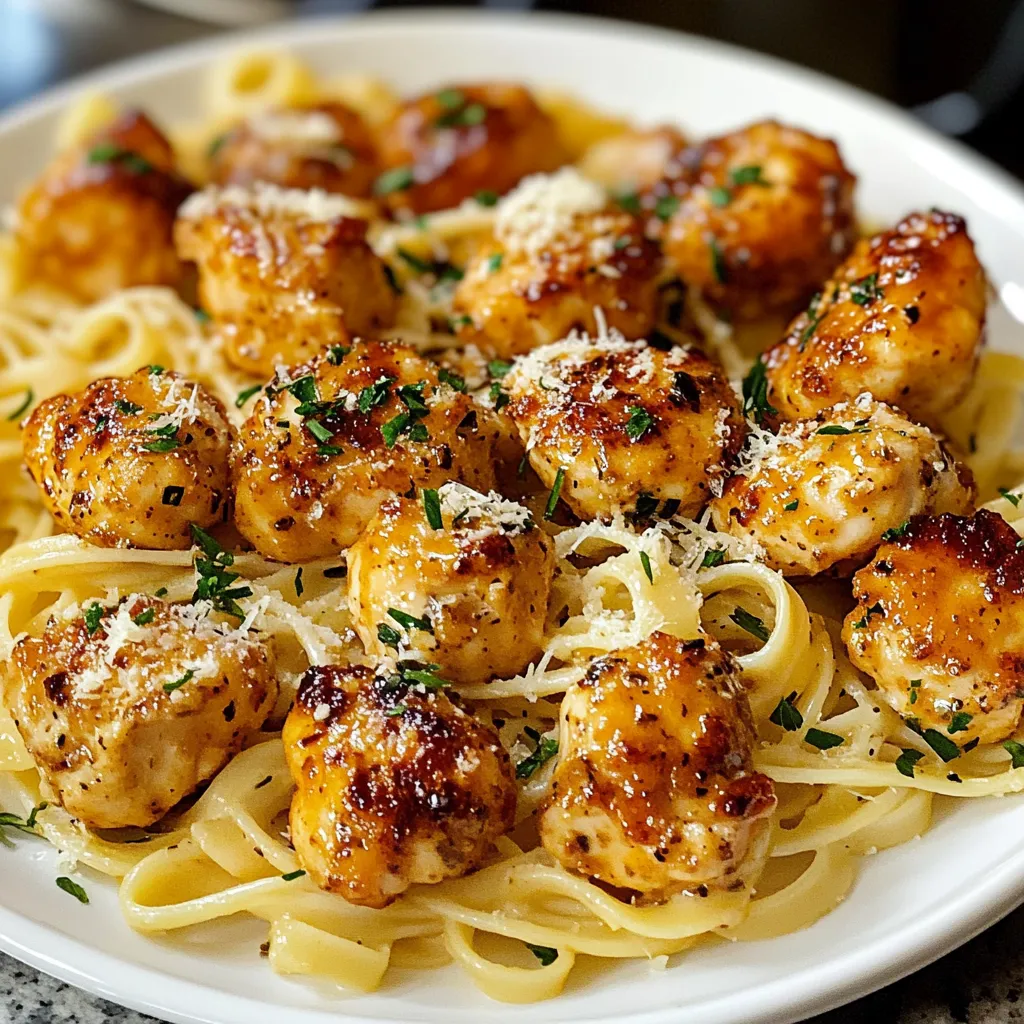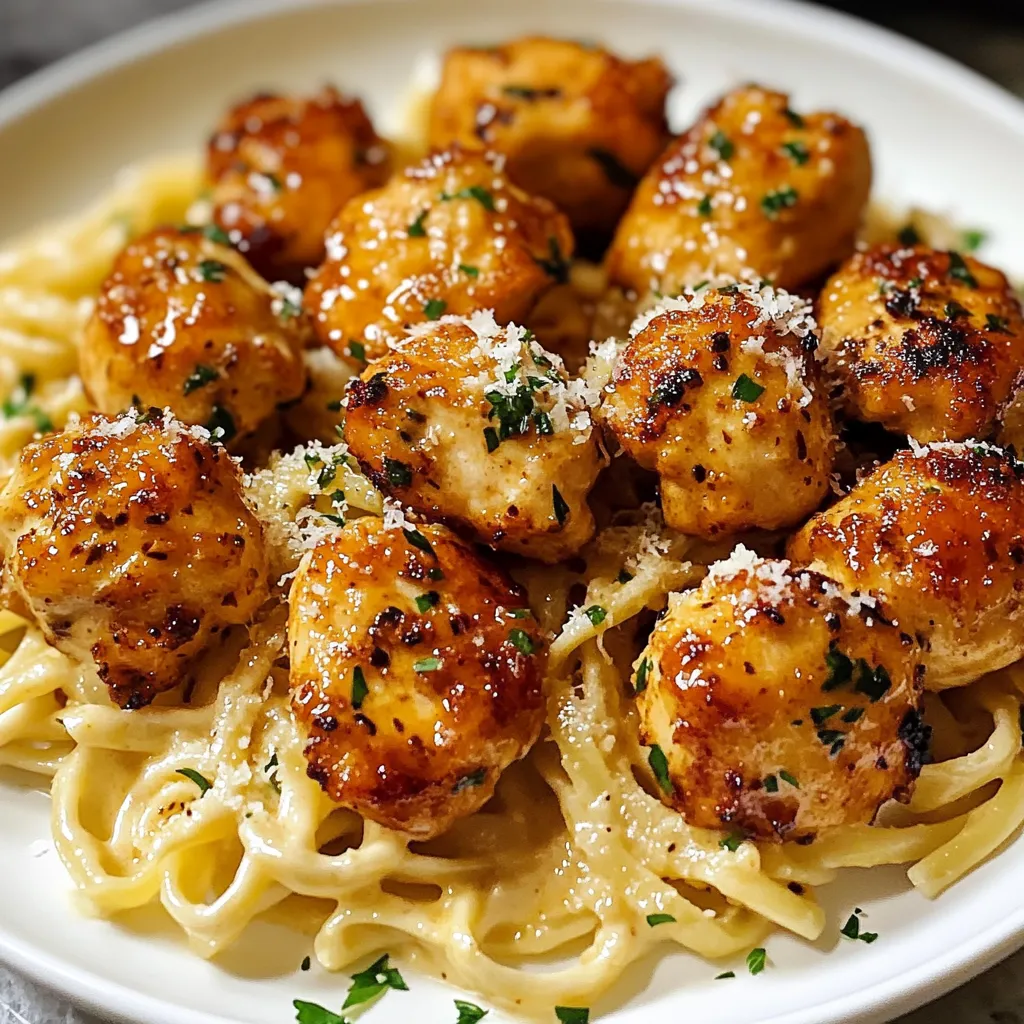 Pin it
Pin it
Garlic Butter Chicken Bites with Creamy Parmesan Pasta creates the perfect fusion of tender chicken and luxurious pasta. Each bite-sized piece of chicken, seared in fragrant garlic butter, nestles into a bed of pasta coated in silky Parmesan cream sauce. This dish transforms simple ingredients into a restaurant-worthy meal that brings together the best of comfort food with elegant presentation.
When I first developed this recipe, I was trying to recreate my grandmother's famous chicken alfredo while simplifying the process. The result exceeded expectations, becoming an instant family favorite that now appears regularly at our Sunday dinners.
Quality Ingredients Matter
- Fresh chicken breast: Choose breasts that are firm and pink, free of any off odors, ensuring quality and freshness.
- European-style butter: This butter offers a richer flavor and promotes better browning for a more appetizing finish.
- Genuine Parmesan cheese: Use authentic Parmesan to create a smooth, deeply flavorful sauce with a complex, nutty profile.
- Heavy cream: Essential for a stable sauce that thickens properly, adding a luxurious, velvety texture.
- Fresh garlic: Freshly minced garlic adds a depth of flavor that surpasses pre-minced alternatives, enhancing the dish's overall aroma.
- High-quality pasta: Opt for pasta that holds sauce well, ensuring every bite is perfectly coated.
- Fresh parsley: Brighten the dish with crisp, vibrant parsley for a pop of color and a fresh herbal finish.
Mastering The Method
- Initial Preparation:
- Begin by cutting chicken into uniform pieces for even cooking. Bring a large pot of generously salted water to boil for pasta. Gather all ingredients and measure them before starting the cooking process.
- Building Flavors:
- Season chicken pieces thoroughly with paprika, salt, and pepper. Heat butter until foamy but not brown. Cook chicken in batches to ensure proper browning and prevent steaming.
- Creating The Sauce:
- Start with gently heated cream, allowing it to reduce slightly before adding cheese. Incorporate Parmesan gradually while whisking continuously. Add pasta water as needed for the perfect consistency.
- Final Assembly:
- Combine components when each is at its peak - pasta still hot and al dente, sauce smooth and flowing, chicken golden and juicy.
 Pin it
Pin it
Growing up in an Italian-American household, I learned that the secret to perfect pasta dishes lies in the balance of flavors and textures. This recipe embodies those principles while adding modern convenience.
Perfect Pairings
Transform this dish into a complete feast by adding thoughtfully chosen sides. A crisp arugula salad with lemon vinaigrette cuts through the richness, while garlic bread makes the perfect vessel for soaking up extra sauce. For a lighter option, serve with roasted broccoli or sautéed green beans that can catch bits of the creamy sauce in their tops.
Creative Adaptations
Experience this recipe in multiple ways by varying the protein or pasta. Try it with shrimp for an elegant seafood version, or use Italian sausage for a heartier variation. Switch up the pasta shape - orecchiette catches the sauce in its little cups, while rigatoni holds the sauce inside its ridges. Add sautéed mushrooms or sun-dried tomatoes for extra depth of flavor.
Smart Storage
Keep leftovers in an airtight container for up to three days. When reheating, add a splash of cream or milk to refresh the sauce. Warm gently over low heat, stirring occasionally to prevent the sauce from separating. The pasta may absorb sauce overnight, so having extra cream on hand helps restore the original consistency.
Temperature Control
Understanding heat management ensures perfect results. Medium-high heat creates a golden crust on the chicken without overcooking. Lower heat when making the sauce prevents the cream from separating and allows the cheese to melt smoothly. Watch for visual cues: the sauce should coat the back of a spoon but still flow easily.
Sauce Mastery
Creating the perfect Parmesan cream sauce requires attention to detail. Start with warm cream to prevent shocking the cheese. Add Parmesan gradually while whisking constantly. If the sauce becomes too thick, thin it with reserved pasta water - never plain water. The starch in the pasta water helps maintain the sauce's silky texture.
Texture Achievement
The key to perfect chicken bites lies in proper cutting and cooking. Make pieces uniform in size, about 1-inch cubes. Don't overcrowd the pan when cooking to ensure each piece develops a golden crust. The chicken should be just cooked through - still juicy but not pink inside.
After years of making pasta dishes, this recipe has become my ultimate comfort food go-to. It combines the satisfaction of perfectly cooked chicken with the luxury of a restaurant-quality cream sauce. Whether served for a family dinner or special occasion, it never fails to impress while remaining approachable enough for any home cook.
 Pin it
Pin it
From my kitchen experiences, I've found that this dish embodies the perfect balance of effort and reward. The techniques are straightforward, but the results are spectacular. Every time I serve it, guests are amazed that such an elegant dish can come together so quickly. The combination of tender chicken, al dente pasta, and silky sauce creates a symphony of textures and flavors that makes any meal feel special.
Frequently Asked Questions
- → Can I use different types of pasta?
- Yes, any pasta shape works well - fettuccine, penne, rigatoni, or rotini are all great choices. Just cook until al dente.
- → How can I make the sauce thicker?
- Let it simmer longer to reduce, or add more Parmesan cheese. The sauce will also naturally thicken as it cools.
- → Can I prepare this dish ahead of time?
- While best served fresh, you can prepare the chicken ahead. When reheating, add a splash of cream to restore the sauce's consistency.
- → What can I substitute for heavy cream?
- Half-and-half can work, though the sauce won't be as rich. For best results, stick with heavy cream.
- → Can I add vegetables to this dish?
- Yes, broccoli, peas, mushrooms, or spinach make great additions. Add them when making the sauce.
